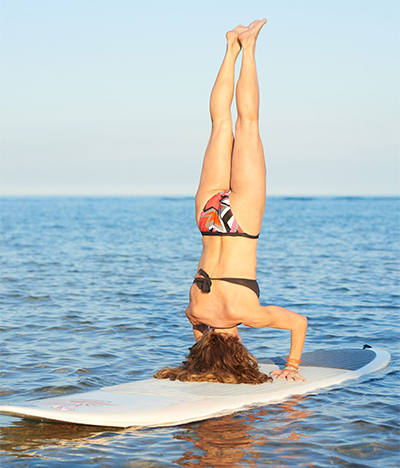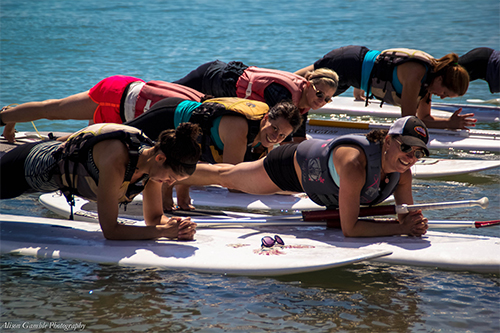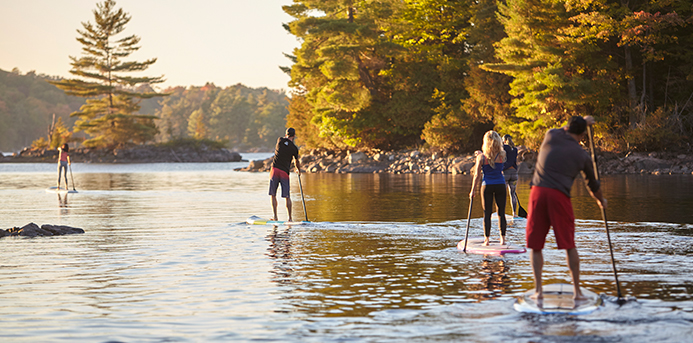Stand-Up Paddleboarding (SUP) is one of the fastest growing sports in the world. According the the Outdoor Foundation, more than 2.8 million people participated in this popular water sport in 2016. If you haven’t seen SUP on a body of water near you, it’s coming!
“I love to SUP and do it whenever and wherever I can,” says Marcia Nowak of Wilmette, Illinois. “I paddle with my sisters in California, friends in Illinois, and my nieces and nephews in Florida. It is great exercise, but also peaceful and meditative. Sometimes we just lay on the boards and look up at the sky.”
While paddling on a board traces back to the 16th century, today’s Stand-Up Paddleboarding has seen incredible growth and recognition as a sport since the early 2000s. Today, you will see SUPs everywhere — oceans, lakes, rivers, ponds, creeks and reservoirs.
The Benefits of SUP
The popularity and growth of SUP is not surprising considering all the benefits:
- Accessible to all body types, ages and athletic abilities
- Easy to learn
- Low equipment requirements and costs (board, paddle and safety equipment)
- Portable
- Low time commitment
- Whole body workout
- Dynamic balance challenge
- Low impact
- Bilateral workout
- Core muscle workout
- Cardio workout
- Stress relieving
- Outdoor activity
- Social activity
Don’t believe us? Just check out all the celebrities, from Bar Rafaeli and Kate Hudson to Katy Perry and Orlando Bloom, who can’t get enough of this awesome workout.
With a little guidance, via a lesson or online tutorial, almost anyone can be up and paddling within a few hours. SUP offers the opportunity to cruise on flat water, surf small swells, strike a yoga pose, explore the coast while on vacation, fish, paddle while your child (or dog) hitches a ride, and even test your fitness at an SUP racing event.
A recent study from the American Council on Exercise concluded that SUP is effective as a core workout and provides a significant balance challenge, amongst other benefits.

“SUP is the most relaxing way to get a full body workout,” says Ian Jacobson of ChicagoSUP. Jacobson was in Hawaii when he got hooked on SUP. He took his passion for the sport and turned it into a booming business in Chicago. Located on North Avenue Beach, ChicagoSUP started with a 10-board fleet, which has grown to 60 boards. Jacobson has all types of clients, but 70 percent are women between the ages of 25-50.
“I suggest that my clients start with a lesson to learn correct technique and safety,” Jacobson says. “Lessons start with beach instruction and then move out onto the water. Most people will catch on after the first lesson.” You can pay by the hour, purchase a 10-hour pass, or get an unlimited pass for the summer.
Find the Right Board
Paddleboard Direct started selling SUPs in 2006 and the growth has been considerable. “SUP appeals to everyone. Most paddlers are looking for an all-around board that all members of the family can use,” Sales Manager Glenn Morton says. Morton consults with buyers to find the right board considering the type of water (flat or wavy), body weight of the users, and experience with paddle sports. Prices range from $549 to $1,100 for an entry level board. Morton is a fan of the inflatable SUP, especially for those that will be transporting the SUP or have little storage. “The inflatable SUPs are super durable, made of material similar to that of a white water raft. It is easy to inflate the SUP in 5-10 minutes, with a hand pump. I check mine as regular luggage and bring it on vacation.”
Morton recommends a few entry-level boards for those looking to commit to SUP:
- Cruiser SUP Crossover Air SL is a high quality inflatable starting at $699
- For a hard board, check out the Cruiser SUP Fusion FeatherLite 10′-11’6″ (for men) or the Cruiser SUP Bliss FeatherLite 10′-11′ (for women), both starting at $749
Boards are equipped with a soft pad for standing in comfort and to help prevent slipping. The pad works well for yoga and is comfortable for relaxing in the sun. Some boards have elastic straps to hold a few essentials like sunscreen, a hat, snacks, or safety items. A leash tethers the board to your ankle. Dockslocks makes a unique lock to secure your paddleboard and paddle to your storage rack.
Safety First
SUP safety is an important consideration before you head out on the water. Taking a lesson, watching a few YouTube videos, and learning from experienced SUP enthusiasts are all great ways to get started. Paddleboards are considered “vessels” when used outside swim areas, per the U.S. Coast Guard. According to Senior Chief Chris Furlow, officer in charge of Coast Guard Station Wilmette Harbor, “When outside of the designated swim area, paddle boarders are required to have a:
- Life jacket
- Sound producing device (whistle)
- Light
“When inside and outside the swim area, we also highly recommend the use of the ankle strap on the paddleboard,” Furlow adds. “Whether a person has done it multiple times or it’s their first time, we suggest they always go out with another person, have the proper safety equipment, understand and recognize their physical limits. Check what the weather will be like for the day, and make sure to include the water and air temperature. These factors have been the main cause in the majority of our Coast Guard rescues.”
Check out these safety tips from the USCG. Wind, waves and currents can quickly take you away from shore, and out of the sight of others. Children are especially vulnerable to losing track of the shore.
Lessons and Classes
“SUP is a unique way to interact with the water. It is like walking on water,” says Keith Heger, program director at The Northwest Passage. Heger points out a few basics that are taught and practiced at their two-hour lessons:
- Mounting the board from hands and knees to balls of the feet, to standing and the first stroke
- Parallel stance on the SUP with weight distributed evenly through each foot
- Paddle height and proper handling of the paddle
- Proper body position while paddling with slightly bent knees, relaxed hips and a straight back
- Falling safely, pushing the board away from you
- Transferring the power from your legs to your upper body
- Connecting each stroke to the next
The Northwest Passage teaches at the beaches in Wilmette and Winnetka, Illinois.

“There no room for ego, judgement or expectations when you are doing poses on a foundation (SUP) that is in constant motion,” says Kristin Andrews, SUP Yoga teacher. “SUP yoga is all about summer fun, a few good laughs and truly experiencing the moment. Beginners are welcome, as I gear each class to the needs of each student.” Start with poses that distribute your weight evenly on the board, then progress to more challenging poses. Andrews suggests trying:
- Table top pose
- Goddess pose
- Forearm plank
- Downdog
- Happy baby
- Tree pose (the hardest!)
Classes are taught at the Northwestern University Sailing Center in Evanston, Illinois. Look for Andrews and her dog, Marley, out on the SUP together.

Whether you live in California, Florida, Colorado, Maine or Illinois, chances are there are opportunities to SUP near your home. Or, if you want to make a trip of it, check out 12 of the most stunning places in the world to go paddleboarding, from Hawaii to Lake Tahoe. This summer is the perfect time to rent a board, discover the joy of being out on the water, challenge your balance, work your whole body, and maybe even indulge in some one-on-one time with someone special. Once you try SUP, you will become a part of the rage.
More from Make It Better:
- Best of 2017: Fitness & Recreation
- The Dangers of Sugar (and How to Eat Less of It)
- The Best Bikes and Cycling Gear for the Whole Family

Christy Coughlin is focused on sharing her passion for healthy living through her writing and coaching. She has a back-to-basics approach based on real food, sensible fitness, and behavior modification. Christy has been a contributor to Make it Better for eight years, focused on, you guessed it, health and fitness. As an ACE certified personal trainer, she has worked with athletes of all ages and abilities, for nearly 20 years. Christy especially enjoys encouraging women to add “a little running” to their fitness program through her Real Running group program. Christy loves to stay fit on the lakefront, doing yoga, running, paddling and swimming.

